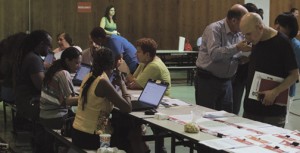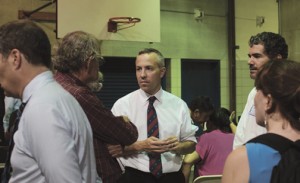On the evening of Wednesday, June 25, city officials and Red Hook locals met in P.S. 15 for a meeting on Hurricane Sandy recovery progress. Sponsored by City Councilman Carlos Menchaca, the meeting was called mainly to inform citizens about the status of programs like Build it Back, and the city’s investments in future disaster prevention.

The school’s gym was filled with representatives from the NYC Housing Authority, the Office of Resiliency and Recovery, the 5th Avenue Commission, Neighbors Helping Neighbors, COJO Flatbush, South Brooklyn Legal Services, and especially the Build it Back program. A long table was set up with six computers and six Build it Back advocates, ready and waiting to offer residents on-the-spot support. At the front, the stage was being set with projectors and microphones while neighborhood residents filed into the auditorium seats. Frustration has been the main sentiment in Red Hook since the storm, due to mainly to disorganized response and relief efforts from the city. Officials have felt this, and tried to use the meeting to address this unhappy situation.
Menchaca cheerleads
The theme of the night was progress and reassurance of the city’s commitment to the neighborhood. Though he arrived late and had to leave early to approve a new budget, councilman Carlos Menchaca delivered a message of optimism to the crowd. “[Build it Back] had been failing us,” he said, “[but] as we engage, beautiful things are going to happen.” Appealing to Red Hook’s unique nature, Menchaca acknowledged that the neighborhood is different from Coney Island, Staten Island, and Rockaway; and as such, the community must get involved to make it work for them. Urging local feedback once more before he left, the councilman left the meeting with a plea: “Don’t stop connecting with us.”
As representatives from several city departments took turns presenting, each offered new means of improving the recovery process. Bill Goldstein, advisor of recovery and resiliency to Mayor de Blasio, spoke first. Goldstein proudly announced that the Mayor has made the recovery process a priority; he has assured 500 construction starts and 500 reimbursement checks to be completed by Labor Day.
Amy Peterson, head of Build it Back, also made an appearance. Build it Back has been a very troubled project since its inception, and Peterson was the first to recognize that. New York City’s answer to the major damage from Hurricane Sandy was meant to offer millions of dollars of assistance to families and businesses reconstructing their homes in the aftermath of the disaster. Five pathways were made available for victims: repair, repair and elevation, reconstruction, reimbursement, or acquisition. However, a combination of factors including poor public communication, confusing qualification guidelines, and changing leadership neutralized the efforts of the program until recently. Amy explained that of the thousands of residents who sustained hurricane damage in Red Hook and Gowanus, only 121 had actually applied to the program. Of those, only eight had selected their assistance option.
But Amy remained optimistic, promising new measures aimed at expediting and simplifying the Build it Back process. She explained that the Department of Housing and Urban Development (HUD) would be eliminating priority levels, meaning that regardless of an applicant’s income level they would receive their assistance in the same amount of time as anyone else. The program would also provide relief from water bills for those with uninhabitable homes. The problem remains, however, that the cutoff date for program registration is long gone, having passed in October 2013.

Though she spoke quickly, Amy also touched on two of the most significant topics for in the post-Sandy discussion: communication and resiliency. She promised the appointment of borough directors to oversee progress more locally, as well as efforts at simplifying public access to Build it Back information and a new web portal allowing applicants to track their status in real time. On issue of rebuilding she advocated raising buildings, skimming over new construction guidelines for base flood elevation, and explaining the option to work with a city contractor or enlisting a private business. In the end her presentation felt rushed, but Amy made herself available after the presentation to address residents’ questions and concerns.
Having Zarrilli a coup
Dan Zarrilli was arguably the most important guest of the night. As Director of the Office of Recovery and Resiliency, Zarrilli plays an active role in nearly all facets of post-Sandy recovery. Working with his own office, the Office of Long-Term Planning and Sustainability (OLTPS) and acting as city liaison to the Federal Emergency Management Agency (FEMA), he is responsible for both rebuilding the damaged areas of the city and preparing it for future disasters.
Zarrilli’s presentation focused on the future instead of dwelling in the past: he addressed several different strategies for making the city more resilient in the long term. Zarrilli also addressed the implications of climate change on the rebuilding plans, taking into account the very real prospects of future weather patterns. Storms like Sandy will become more frequent as climate change continues, and Zarrilli claims that by 2050 sea levels will rise between 1-2 feet. For communities like Red Hook, such drastic changes would spell huge problems even beyond the scope of Sandy’s damage. “Sandy showed us our vulnerability,” he explained. But that gives us the opportunity to “build resilience into everything we do.”
The Office of Recovery and Resiliency has drafted multiple lines of defense against future disasters. Among these are plans to strengthen coastlines, upgrade buildings, create protections around infrastructure and services, and to ultimately make affected neighborhoods safer and more vibrant. According to Dan, the city currently has 257 initiatives in the works, which he says “is good progress, but it’s still early.” As a tangible example, Zarrilli claims that Con Edison will be adopting information and projections on climate change for their power grids, meaning that they should be able to handle storm damage better.
The centerpiece of the neighborhood defense is the proposed Integrated Flood Protection System, about which there has been some confusion. Zarrilli described a combination of temporary and permanent solutions, including improved drainage systems and deployable water walls. The advantage to these smaller piecemeal protections is that Red Hook waterfronts will remain open and unhindered until the arrival of a storm, at which point these walls can be deployed as a first line of defense. Such designs are to be made in collaboration with the Army Corps of Engineers. Zarrilli’s main goal as of now is to secure funds for these protections and to expedite the approval process through both FEMA and New York State. As he promised several times, “the city is absolutely committed to this project,” and Zarrilli seems intent on keeping that promise.
Last to take the stage was NYC Housing Authority (NYCHA) Vice-President for Disaster Recovery, Mike Rosen. Rather than deliver excuses, Rosen made a point of sympathizing with Red Hook residents as he explained the state of recovery. According to the NYCHA rep, Sandy affected over 700 buildings, including 35 developments with significant damage. NYCHA remains in negotiations with FEMA, which is why they have only managed temporary repairs as they await their funding. Rosen estimates that the recovery twice exceeds NYCHA’s entire 5-year capital plan. In short, his department is just as frustrated as the residents.
Houses still waiting for better boilers
Temporary repairs are the most pressing issue as NYCHA continues waiting for federal funding, and boilers have been the subject of much debate. Rosen admitted that the oil-burning boilers that many NYCHA buildings have been using since Sandy were less than ideal: they are expensive, noisy, high in pollution, older, and harder to maintain. But there was positive news, too, amidst the commiseration: Rosen announced that they would be replacing these older machines with gas boilers instead. Rather than renting them, NYCHA would be purchasing these boilers at favorable rates, enough that each development would get two mobile boilers to ensure proper heating even if one is under maintenance.
Though permanent work remains subject to federal funding, Rosen took the optimistic stance: “We can leverage this disaster to make our buildings better than they were before Sandy.” Though both the department and the neighborhood will continue playing the waiting game with federal money, improvements are already being designed. New permanent boilers will be elevated and placed outside of basements; heat distributors will be replaced; crawl spaces and entrances will be waterproofed; exterior lighting will be upgraded; solar-powered emergency lighting systems will be installed; and local developments will have backup power generators for the first time in NYC public housing history.
The official presentations ended on this positive note, and attendees were encouraged to speak with the representatives stationed around the auditorium. Build it Back desks were filled with Red Hook citizens seeking guidance on their applications, while the presenters stuck around to answer questions. Not everyone was impressed, however. Sheryl Braxton, one of the local attendees, was still skeptical. “People don’t know what to expect here,” she said, after expressing her disillusionment with the city’s efforts. If there are so few results, she questions, “Why are we having all these meetings?” But Dan Zarrilli remained optimistic. Echoing his earlier statements, he insists that the city is making a “meaningful commitment” to the neighborhood, and is dedicated to finishing both rebuilding and creating future protections. Only time will tell the success of these efforts, and until then Red Hook continues a slow, but hopeful recovery.









One Comment
Review will be in the London Review of Books. Nagel’s book is very interesting. He’s got far too much repcset for the intelligent design’ movement, and that is a weak point in the book. But on the mind-body problem and how that problem seeps out and affects other issues, much more thought-provoking.